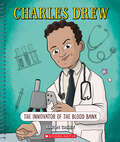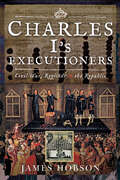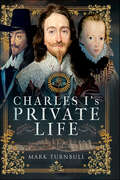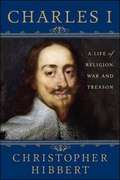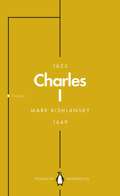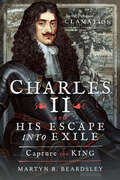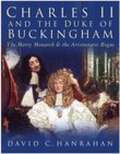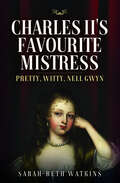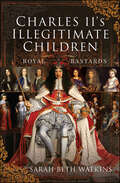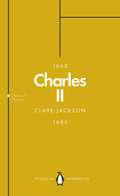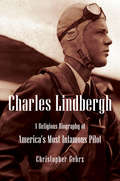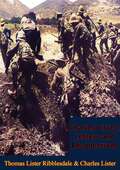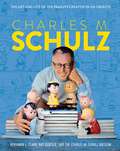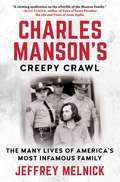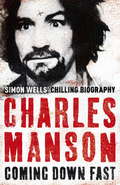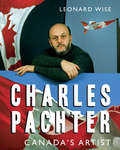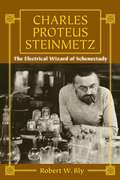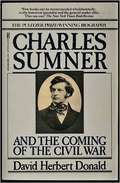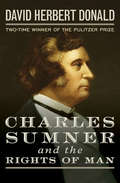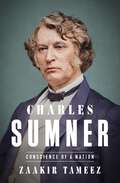- Table View
- List View
Charles Drew: The Innovator Of The Blood Bank (Bright Minds)
by Aaron TalleyMeet the inventors and scientists of color who changed the world!Born in Washington, D.C., in 1904, Charles R. Drew was a Black surgeon and medical researcher. Known as the “Father of The Blood Bank,” he researched in the field of blood transfusions, and developed improved techniques for blood storage. Among his many accomplishments, he developed America’s first large-scale blood bank during World War II. It is time to remember how Charles R. Drew's inventions and his contributions changed our society… and our world!ABOUT THE SERIES:Many inventors and scientists of color have made incredible contributions to our modern life. Each volume in this much-needed new series will be devoted to the life and work of one of these inventors and scientists. With a vivid writing style that will use humor as one of its primary ingredients, and illustrated with a combination of real photos and pictures featuring graphic art, each title in this series will describe how these heroes of diverse backgrounds faced the challenges of their times, and how their inventions and contributions changed our society.
Charles Fort: Prophet of the Unexplained
by Damon KnightFrom the book: Charles Fort was convinced that there is a great deal going on in our universe which man has not as yet been able to explain. He was, of course, right. Fort amassed reports of events allegedly observed by humans around the world. Fort's books are full of reports of strange phenomena-such as those similar in every way to today's reports of flying saucers but centuries before they were called flying saucers. Boole gave scientists a powerful tool for attacking problems when the obvious approaches refused to yield informative results. Boole employed reductio ad absurdum. He exhausted all the impossibles and thereby isolated a "very probable" answer. Charles Fort, failing to gain the publishers'-and thereby society's-consideration of his positive theories, left world society with a Boolean-like confrontation of illogical events. Charles Fort as a man of true vision purposefully inverted the equations. By getting the publishers to publish the absurd, he proved his point that the publishers published only the absurd.
Charles Francis Adam 1807-1885
by Martin DubermanThis is Martin Duberman's biography of Charles Francis Adams (1807-1886), grandson of John Adams, son of John Quincy Adams and Louise Johnson. Charles Francis Adams served in the U.S. House of Representatives on behalf of Massachusetts from 1859 to 1861, just prior to the Civil War and was an envoy to the United Kingdom during and after that war. He was noted for his upright character, his participation along with Secretary Seward in treaty negotiations with England regarding financial damages to the North, and compiled the papers and wrote a biography of his grandfather. Duberman's book was first published in 1961 and then reissued by Stanford University in 1968. MARTIN DUBERMAN is Distinguished Professor of History, Emeritus, at City University of New York, where he founded and directed the Center for Lesbian and Gay Studies. He is the author of numerous histories, biographies, memoirs, essays, plays, and novels, which include Cures: A Gay Man's Odyssey, Paul Robeson; Stonewall; Midlife Queer: Autobiography of a Decade, 1971-1981; Black Mountain: An Exploration in Community; The Worlds of Lincoln Kirstein; Jews/Queers/Germans; and more than a dozen others. His biography of Charles Francis Adams won the Bancroft Prize, and his coedited anthology Hidden from History: Reclaiming the Gay and Lesbian Past won two Lambda Literary Awards. He won a third Lambda Award for Hold Tight Gently: Michael Callen, Essex Hemphill, and the Battlefield of aids. Duberman received the 2007 Lifetime Achievement Award from the American Historical Association, as well as two honorary degrees: Doctor of Humane Letters from Amherst College, and Doctor of Letters from Columbia University. He was also a finalist for the Pulitzer Prize and the National Book Award.
Charles I and the Aristocracy, 1625-1642
by Richard CustThis is a major new study of Charles I's relationship with the English aristocracy. Rejecting the traditional emphasis on the 'Crisis of the Aristocracy', Professor Richard Cust highlights instead the effectiveness of the King and the Earl of Arundel's policies to promote and strengthen the nobility. He reveals how the peers reasserted themselves as the natural leaders of the political nation during the Great Council of Peers in 1640 and the Long Parliament. He also demonstrates how Charles deliberately set out to cultivate his aristocracy as the main bulwark of royal authority, enabling him to go to war against the Scots in 1639 and then build the royalist party which provided the means to fight parliament in 1642. The analysis is framed throughout within a broader study of aristocratic honour and the efforts of the heralds to stabilise the social order.
Charles I's Executioners: Civil War, Regicide & the Republic
by James HobsonThis biographical history of the English Civil War profiles the lives and ultimate fates of the nearly 60 men who sentenced their king to death.On January 30th, 1649, King Charles I was executed on a scaffold outside the Banqueting House of Whitehall. The parliamentarian High Court of Justice declared him guilty of treason, disregarding the Divine Right of Kings. Fifty-nine commissioners signed his death warrant. These killers of the king were soldiers, lawyers, Puritans, Republicans—and some mere opportunists—all brought together under one infamous banner. In Charles I’s Executioners, James Hobson explores the lives of these men, shedding new light on their backgrounds, ideals, and motives.Their stories are a powerful tale of revenge and clashing convictions; their futures determined by their one fateful decision. When Charles II was restored, he enacted a deadly wave of retribution against the signatories. Some pleaded for mercy, many went into hiding or fled abroad, while others stoically awaited their sentence.
Charles I's Private Life
by Mark TurnbullThe execution of King Charles I is one of the well-known facts of British history, and an often-quoted snippet from our past. He lost the civil war and his head. But there is more to Charles than the civil war and his death. To fully appreciate the momentous events that marked the twenty-four years of his reign, and what followed, it’s important to understand the man who was at their epicenter. Both during his lifetime, and in the centuries since, opinion of Charles is often polarized; he is either Royal Martyr or Man of Blood. Amidst these extremes, what is frequently overshadowed is the man himself. Propaganda still clouds his personality, as do the events of his last seven years of life. The first half of his life has not been explored in detail. As a sickly second son of the first King of Great Britain, these years shed light on the development of Charles’s character. Key elements of his final days also remain lost to us, such as certain identification of his executioners. Investigating new evidence, an entirely new candidate is proposed. Persistent myths surrounding his health and supposed unwillingness to compromise are also addressed. There are many biographies, but this most intimate work draws upon fresh viewpoints and contemporary letters, some never before used. Penetrating the veil of monarchy and getting to the heart of the man through his relationships, the reader is brought closer than ever to the real Charles Stewart. A brave, principled and dutiful man, he was politically flawed and lacked the ruthlessness needed to steer his three kingdoms beyond the crossroads at which they arrived. Above all, he is a character who shares much in common with us all. "This is the story of the spare who became the heir: what shaped him - and what became of him. Mark Turnbull helps us understand Charles the king as Charles the man" - Leanda de Lisle
Charles I: A Life of Religion, War and Treason
by Christopher HibbertWhen Charles Stuart was a young child, it seemed unlikely that he would survive, let alone become ruler of England and Scotland. Once shy and retiring, an awkward stutterer, he grew in stature and confidence under the guidance of the Duke of Buckingham; his marriage to Henrietta of Spain, originally planned to end the conflict between the two nations, became, after rocky beginnings, a true love match. Charles I is best remembered for having started the English Civil War in 1642 which led to his execution for treason, the end of the monarchy, and the establishment of a commonwealth until monarchy was restored in 1660. Hibbert's masterful biography re-creates the world of Charles I, his court, artistic patronage, and family life, while tracing the course of events that led to his execution for treason in 1649.
Charles I: An Abbreviated Life (Penguin Monarchs)
by Mark KishlanskyThe tragedy of Charles I dominates one of the most strange and painful periods in British history as the whole island tore itself apart over a deadly, entangled series of religious and political disputes. In Mark Kishlansky's brilliant account it is never in doubt that Charles created his own catastrophe, but he was nonetheless opposed by men with far fewer scruples and less consistency who for often quite contradictory reasons conspired to destroy him. This is a remarkable portrait of one of the most talented, thoughtful, loyal, moral, artistically alert and yet, somehow, disastrous of all this country's rulers.
Charles II and his Escape into Exile: Capture the King
by Martyn R. Beardsley"Unreservedly recommended for personal reading lists, as well as community, college, and university library Historical Royal British Biographies collections." – Midwest Book ReviewReturning to England to try to reclaim his throne, King Charles II was defeated at the Battle of Worcester – but the battle to save his own life had only just begun. Pursued wherever he went by soldiers from the conflict as well as local militia, Charles donned peasant clothing, crudely cut his hair and tried to adopt a rustic accent. With the secret help of a succession of loyal citizens, he walked till his feet were shredded, waded rivers, coolly mixed with anti-royalists and enemy troopers – and, of course, hid in an oak tree. Never sure of who could be trusted, it was touch and go all the way to the coast and, hopefully, a boat that would take him to freedom.
Charles II and the Duke of Buckingham: The Merry Monarch and the Aristocratic Rogue
by David C HanrahanPaints a picture of friendship, exile, betrayal, murder, adultery, infamy, alchemy and scandal in royal and courtly circles. Buckingham was brought up in court with the two kings, James II and Charles II - his own father. The author investigates why Charles remained true to his childhood friend despite Buckingham's ingratitude.
Charles II's Favourite Mistress: Pretty, Witty Nell Gwyn
by Sarah-Beth WatkinsNell Gwyn, the most infamous mistress of Charles II, was a commoner raised from the dingy back alleys of London to the stage and into a king’s arms. Hers was a true rags to riches story that saw a young girl rise from selling oranges to capturing the heart of a king. The Restoration period was one of change. After the troubled years of the English Civil War, it was time for pleasure, debauchery and entertainment with the ‘Merry Monarch’ restored to the throne. Nell was one of the first actresses on stage; a loveable comedienne who wowed audiences with her wit and charm. She fell in love with Charles Hart (one of the leading actors of the time), had a torrid affair with Lord Buckhurst and ultimately ended up in the king’s bed. She stayed on the stage for six years, but she stayed in the king’s heart for seventeen – his only mistress who was faithful to him. Set against the backdrop of Restoration London, this book charts Nell’s life and that of her family and friends – from her drunken mother and troublesome sister to the most notorious wits of the age John Wilmot, 2nd Earl of Rochester and George Villiers, 2nd Duke of Buckingham. Nell had a generous heart and a mischievous spirit, and was friends with people from all walks of life. The only woman she really detested was another of the king’s mistresses, Louise de Kerouaille, known as the French Spy. This highly entertaining book will tell the story of Nell’s life – the good and the bad – and show why Nell truly embodies the spirit of the Restoration.
Charles II's Illegitimate Children: Royal Bastards
by Sarah-Beth WatkinsCharles II had at least twelve illegitimate children that we know of. Although his queen, Catherine of Braganza, fell pregnant several times she was not able to bear any children to full term. The king, who was known for his many mistresses, had his first recognized child out of wedlock in 1649; the child was James Croft who would become Duke of Monmouth and mastermind of an infamous rebellion. Not all of his children would gain such notoriety but they would live long and full lives creating a Stuart bloodline that descends to the present day. There was Nell Gywn’s son, Charles Beauclerk, Duke of St Albans who was present at the siege of Belgrade in 1688. The French mistress, Louise de Keroualle’s son, Charles Lennox, Duke of Richmond who was an early patron of cricket. Catherine Pegge’s son, Charles Fitzcharles, 1st Earl of Plymouth who was a colonel in the King’s Own Royal Regiment and lost his life in Tangier and Moll Davis’ daughter Mary Tudor, Countess of Derwentwater who separated from her husband because she refused to be a Catholic. Not to mention Charles’s offspring by Barbara Villiers, Lady Castlemaine and later Duchess of Cleveland – there was Anne who had an affair with one of her father’s mistresses, Charles who succeeded to the dukedom of Cleveland, Henry who became vice-admiral of England, George who was in the secret service in Venice, Barbara who after a torrid affair with the Earl of Arran gave birth to illegitimate twins and became a nun in France and Charlotte, who became Countess of Lichfield and had eighteen children! And then there are the stories of other children like James de la Cloche and Charlotte Boyle whose births and lives are shrouded in mystery and rumor. This book will bring to life the king’s many illegitimate children and tell their stories.
Charles II: The Star King (Penguin Monarchs)
by Clare JacksonCharles II has always been one of the most instantly recognisable British kings - both in his physical appearance, disseminated through endless portraits, prints and pub signs, and in his complicated mix of lasciviousness, cynicism and luxury. His father's execution and his own many years of exile made him a guarded, curious, unusually self-conscious ruler. He lived through some of the most striking events in the national history - from the Civil Wars to the Great Plague, from the Fire of London to the wars with the Dutch.Clare Jackson's marvellous book takes full advantage of its irrepressible subject.
Charles Lamb And His Friends
by William Dean HowellsBiography stressing the environment and colleagues of the well known author.
Charles Lindbergh
by Anne SchraffBiography of the famous aviator. Guided by Time Magazine's list of 100 most influential people, this series of biographies focuses on the leaders, scientists, and icons who shaped our world. Each biography includes a glossary, timeline, and illustrations.
Charles Lindbergh: A Religious Biography of America's Most Infamous Pilot (Library of Religious Biography (LRB))
by Christopher GehrzThe narrative surrounding Charles Lindbergh&’s life has been as varying and complex as the man himself. Once best known as an aviator—the first to complete a solo nonstop transatlantic flight—he has since become increasingly identified with his sympathies for white supremacy, eugenics, and the Nazi regime in Germany. Underexplored amid all this is Lindbergh&’s spiritual life. What beliefs drove the contradictory impulses of this twentieth-century icon? An apostle of technological progress who encountered God in the wildernesses he sought to protect, an anti-Semitic opponent of US intervention in World War II who had a Jewish scripture inscribed on his gravestone, and a critic of Christianity who admired Christ, Lindbergh defies conventional categories. But spirituality undoubtedly mattered to him a great deal. Influenced by his wife, Anne Morrow Lindbergh—a self-described &“lapsed Presbyterian&” who longed to live &“in grace&”—and friends like Alexis Carrel (a Nobel Prize–winning surgeon, eugenicist, and Catholic mystic) and Jim Newton (an evangelical businessman), he spent much of his adult life reflecting on mortality, divinity, and metaphysics. In this short biography, Christopher Gehrz represents Lindbergh as he was, neither an adherent nor an atheist, a historical case study of an increasingly familiar contemporary phenomenon: the &“spiritual but not religious.&” For all his earnest curiosity, Lindbergh remained unwilling throughout his life to submit to any spiritual authority beyond himself and ultimately rejected the ordering influence of church, tradition, scripture, or creed. In the end, the man who flew solo across the Atlantic insisted on charting his own spiritual path, drawing on multiple sources in such a way that satisfied his spiritual hunger but left some of his cruelest convictions unchallenged.
Charles Lister; Letters and Recollections, With a Memoir by his Father, Lord Ribblesdale
by Thomas Lister Ribblesdale Charles ListerIncludes Gallipoli Campaign Map and Illustrations Pack -71 photos and 31 maps of the campaign spanning the entire period of hostilities.“With the Hood Battalion during the campaign in the DardanellesAlthough there remains much interest in the activities of the Royal Naval Division during the First World War, there is little original material on the subject readily available. The letters which form a substantial part of this book, may have been overlooked by many readers since they were originally published under a title that gave no indication that the book was about service with ‘the sailors in khaki’. Charles Lister was a frequent correspondent with his family and friends while travelling abroad before the outbreak of war, and he continued this correspondence throughout his military service until he died of wounds sustained while serving with the Hood Battalion of the Royal Naval Division during the Gallipoli campaign. After his death, Lister’s father, Lord Ribblesdale, published his son’s letters as a memorial.”-Print ed.
Charles M. Schulz: The Creator of PEANUTS in 100 Objects
by Nat Gertler The Charles M. Schulz Museum Benjamin L. ClarkCharles M. Schulz: The Life and Art of the Creator of Peanuts in 100 Objects explores the man behind one of America&’s most iconic comic strips and its beloved cast of characters—Charlie Brown, Snoopy, and the rest of the Peanuts Gang. Through 100 preserved and cataloged artifacts, delve into Charles M. Schulz&’s Minnesota youth in 1920s America, Schulz&’s WWII Army service, and Schulz&’s path to fame through his post-war comic series Li&’l Folks and five decades of Peanuts. From Schulz&’s first published drawing featured in Ripley&’s Believe It or Not! to his 2001 Congressional Gold Medal, the 100 artifacts bring the details of the singular artist to life. Along with provocative, witty, and wise quotes, fan-favorite strips, and more, this book is a must-have for any Peanuts fan. 100 OBJECTS: Carefully curated artifacts from Charles M. Schulz&’s home and studio—including medals and awards, family photos, rare comic art, and more—tell the story of this beloved artist&’s life, career, and the times in which he lived. EXPLORE AMERICANA: From his youth in 1920&’s Minnesota through the turbulent 60s and beyond, Charles Schulz&’s life spans the rich history of the American Century. CLASSIC STRIPS: Includes timeless Peanuts comic strips featuring Charlie Brown, Snoopy, and the whole Peanuts Gang. FASCINATING FACTS: Fans of Peanuts will find never-before-seen items that give them an intimate look at the creation of the acclaimed comic strip series. OFFICIAL ACCOUNT: Created in collaboration with the Charles M. Schulz estate, the book provides an exclusive look into the life of one of America&’s most revered artists.
Charles Manson's Creepy Crawl: The Many Lives of America's Most Infamous Family
by Jeffrey MelnickWith a new epilogue updated from its hardcover edition titled Creepy Crawling: Charles Manson and the Many Lives of America's Most Infamous Family "Creepy crawling" was the Manson Family's practice of secretly entering someone's home, and without harming anyone, leaving only a trace of evidence that they had been there, some reminder that the sanctity of the private home had been breached. Now, author Jeffrey Melnick reveals just how much the Family creepy crawled their way through Los Angeles in the sixties and then on through American social, political, and cultural life for fifty years, firmly lodging themselves in our minds. Even now, it is almost impossible to discuss the sixties, teenage runaways, sexuality, drugs, music, California, or even the concept of family without referencing Manson and his "girls." Not just another Charles Manson history, Charles Manson's Creepy Crawl: The Many Lives of America's Most Infamous Family explores how the Family weren't so much outsiders as emblematic of the Los Angeles counterculture freak scene, and how Manson worked to connect himself to the mainstream of the time. Ever since they spent two nights killing seven residents of Los Angeles—what we now know as the "Tate-LaBianca murders"—the Manson family has rarely slipped from the American radar for long. From Emma Cline's The Girls to the TV show Aquarius, as well as two major films in 2019, including Quentin Tarantino's Once Upon a Time in Hollywood, the family continues to find an audience. What is it about Charles Manson and his family that captivates us still? Author Jeffrey Melnick sets out to answer this question in this fascinating and compulsively readable cultural history of the Family and their influence from 1969 to the present.
Charles Manson: Coming Down Fast
by Simon Wells*The definitive and bestselling account of Charles Manson*'A sprawling, fast-paced account of Manson's life' The Times'Fascinating' Daily Mail __________Los Angeles, California. 1969. Seven people are found shot, stabbed and beaten to death in Beverley Hills. Among them is actress Sharon Tate, the beautiful young wife of Roman Polanski.It soon became apparent that a happyish cult known as 'The Family' was responsible. Their charismatic and manipulative leader, Charles Manson, took the public's imagination. As the world watched in morbid fascination, the sensational and horrifying details of the case slowly emerged.Coming Down Fast is the definitive and most revealing account of one of the most notorious criminals in history, charting Manson's terrifying rise from petty-criminal to one of the most recognisable icons in criminal history. Including never-before-published photographs, this is the definitive book about Charles Manson.
Charles Pachter: Canada's Artist
by Margaret Atwood Tom Smart Leonard WiseAn Officer of the Order of Canada, Chevalier of France’s Order of Arts and Letters, and recipient of the Order of Ontario, painter, printmaker, sculptor, designer, and author, Charles Pachter is one of Canada’s best-loved and most celebrated artists. Pachter is an artist with an astonishing range. His work is witty, thoughtful, moving, and personal. Many works, like Queen on Moose, The Painted Flag, and Hockey Knights in Canada, have achieved a remarkable level of recognition, becoming famous across the country — indeed, around the world. His collaboration with Margaret Atwood on The Journals of Susanna Moodie has been called “truly the most magnificent book ever to be published in Canada.” Charles Pachter: Canada’s Artist is a celebration of the life and work — the struggles and triumphs — of a man who has helped to redefine Canadian art. Pachter’ promotion of Canada and its culture has left a lasting legacy — one that he continues to build on.
Charles Proteus Steinmetz
by Robert W. BlyRevered in the late 19th and early 20th centuries as a genius, but largely forgotten today, Steinmetz made the modern world possible through his revolutionary work on AC electricity transmission, the technology underlying today's power grid. More than just a great scientist and engineer, Steinmetz was also one of the most colorful characters in American life. Standing just four feet tall with a pronounced spine curvature, Steinmetz was as well known for his fiery political opinions, his fierce advocacy for social progress and education, his unusual home life, and his private menagerie as for his technical achievements.
Charles Sumner and the Coming of the Civil War
by David Herbert DonaldIn a period when senators exercised more influence than presidents, Senator Charles Sumner was one of the most powerful forces in the American government. His uncompromising moral standards made him a lightning rod in an era fraught with conflict.<P><P> Pulitzer Prize Winner
Charles Sumner and the Rights of Man
by David Herbert DonaldA Pulitzer Prize winner's &“magisterial&” biography of the Civil War–era Massachusetts senator, a Radical Republican who fought for slavery&’s abolition (The New York Times). In his follow-up to Charles Sumner and the Coming of the Civil War, acclaimed historian David Herbert Donald examines the life of the Massachusetts legislator from 1860 to his death in 1874. As a leader of the Radical Republicans, Sumner made the abolition of slavery his primary legislative focus—yet opposed the Thirteenth, Fourteenth, and Fifteenth Amendments to the US Constitution for not going far enough to guarantee full equality. His struggle to balance power and principle defined his career during the Civil War and Reconstruction, and Donald masterfully charts the senator&’s wavering path from fiery sectarian leader to responsible party member. In a richly detailed portrait of Sumner&’s role as chairman of the Senate Committee on Foreign Relations, Donald analyzes how the legislator brought his influence and political acumen to bear on an issue as dear to his heart as equal rights: international peace. Authoritative and engrossing, Charles Sumner and the Rights of Man captures a fascinating political figure at the height of his powers and brings a tumultuous period in American history to vivid life.
Charles Sumner: Conscience of a Nation
by Zaakir Tameez"A thorough recounting of the great legislator’s life and deed... unlikely to be bettered anytime soon... Tameez is expert at explaining Sumner’s legal thought... One cannot help wishing we had a Charles Sumner in Washington today."—The New York Times"An excellent book about the courageous Massachusetts senator... Drawing from hundreds of letters, articles and speeches, Mr. Tameez has created a remarkable portrait of a complex man who faced many personal challenges... Charles Sumner is a moving portrayal of a courageous, long-overlooked American who, in the words of one contemporary, 'stood in the vanguard of Freedom.'”—Wall Street JournalA landmark biography of Charles Sumner, the unsung hero of the American Civil War and ReconstructionCharles Sumner is mainly known as the abolitionist statesman who suffered a brutal caning on the Senate floor by the proslavery congressman Preston Brooks in 1856. This violent episode has obscured Sumner’s status as the most passionate champion of equal rights and multiracial democracy of his time. A friend of Alexis de Tocqueville, an ally of Frederick Douglass, and an adviser to Abraham Lincoln, Sumner helped the Union win the Civil War and ordain the Emancipation Proclamation, the Thirteenth Amendment, the Freedmen’s Bureau, and the Civil Rights Act of 1875. In a comprehensive but fast-paced narrative, Zaakir Tameez presents Sumner as one of America’s forgotten founding fathers, a constitutional visionary who helped to rewrite the post–Civil War Constitution and give birth to modern civil rights law. He argues that Sumner was a gay man who battled with love and heartbreak at a time when homosexuality wasn’t well understood or accepted. And he explores Sumner’s critical partnerships with the nation’s first generation of Black lawyers and civil rights leaders, whose legal contributions to Reconstruction have been overlooked for far too long.An extraordinary achievement of historical and constitutional scholarship, Charles Sumner brings back to life one of America’s most inspiring statesmen, whose formidable ideas remain relevant to a nation still divided over questions of race, democracy, and constitutional law.
